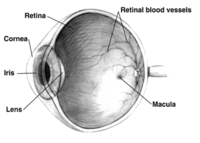
Photo from wikipedia
Purpose of ReviewThe diameter of retinal vessels is an important source of information about retinal blood flow and metabolism. The purpose of the present study is to review how diameter… Click to show full abstract
Purpose of ReviewThe diameter of retinal vessels is an important source of information about retinal blood flow and metabolism. The purpose of the present study is to review how diameter changes of retinal vessels contribute to the development of diabetic retinopathy and may be a marker of the prognosis of the disease.Recent FindingsThe early stages of diabetic retinopathy are accompanied with dilatation of the diameter of retinal vessels and reduced autoregulation. Diabetic retinopathy also shows regional differences in the macular area and the retinal periphery and accompanying differences in vascular reactivity in these areas. These differences may potentially become an important source of insight into the pathophysiology of the disease in the future.SummaryDiabetic retinopathy is accompanied with changes in the diameter regulation of retinal vessels. The potential of newly developed techniques for assessing retinal blood flow and metabolism, such as Doppler techniques, adaptive optics, and retinal oximetry, is promising and may potentially contribute to significant advances in our understanding of diabetic retinopathy which remains a major cause of visual impairment.
Journal Title: Current Diabetes Reports
Year Published: 2017
Link to full text (if available)
Share on Social Media: Sign Up to like & get
recommendations!